I'm getting strange/incorrect results from RGeo polygon intersection functions (Ruby 2.3.0, RGeo 0.5.3)
EXAMPLE 1:
I have two polygons which I believe share a boundary but do not share any internal space (i.e. they touch but do not overlap):
wkt_1 = "POLYGON ((-8226874.27782158 4962626.76394919, -8223358.174520462 4961756.817075645, -8223358.174520462 4960289.557693501, -8224471.369428394 4960289.557693501, -8226874.27782158 4962253.674727506, -8226874.27782158 4962626.76394919))"
wkt_2 = "POLYGON ((-8224757.546680832 4960523.476563589, -8225269.1002275925 4959296.105368667, -8226993.791361805 4959219.668340384, -8226420.900079966 4961883.087589158, -8224757.546680832 4960523.476563589))"
poly_1 = RGeo::Geos.factory(:srid => 3857).parse_wkt(wkt_1)
poly_2 = RGeo::Geos.factory(:srid => 3857).parse_wkt(wkt_2)
When we check the intersection between them, it returns a line, as expected for geometries sharing only a boundary:
poly_1.intersection poly_2
=> #<RGeo::Geos::CAPILineStringImpl:0x3fc0249af168 "LINESTRING (-8224757.546680832 4960523.476563589, -8225598.074380083 4961210.51680879)">
However, when running the following checks, we get the opposite of what's expected:
poly_1.overlaps? poly_2
=> true
poly_1.touches? poly_2
=> false
EXAMPLE 2:
We take two legitimately overlapping polygons:
wkt_3 = "POLYGON ((-8243237.0 4970203.0, -8243237.0 4968735.0, -8242123.0 4968735.0, -8242123.0 4970203.0, -8243237.0 4970203.0))"
wkt_4 = "POLYGON ((-8244765.0 4966076.0, -8244765.0 4964608.0, -8243652.0 4964608.0, -8243652.0 4966076.0, -8242680.0 4969362.0, -8244765.0 4966076.0))"
poly_3 = RGeo::Geos.factory(:srid => 3857).parse_wkt(wkt_3)
poly_4 = RGeo::Geos.factory(:srid => 3857).parse_wkt(wkt_4)
And calculate the differences in both directions:
diff_a = poly_3.difference poly_4
=> #<RGeo::Geos::CAPIPolygonImpl:0x3fe3fca26028 "POLYGON ((-8243077.837796713 4968735.0, -8243237.0 4968735.0, -8243237.0 4970203.0, -8242123.0 4970203.0, -8242123.0 4968735.0, -8242865.466828971 4968735.0, -8242680.0 4969362.0, -8243077.837796713 4968735.0))">
diff_b = poly_4.difference poly_3
=> #<RGeo::Geos::CAPIPolygonImpl:0x3fe3fd1dda28 "POLYGON ((-8242865.466828971 4968735.0, -8243652.0 4966076.0, -8243652.0 4964608.0, -8244765.0 4964608.0, -8244765.0 4966076.0, -8243077.837796713 4968735.0, -8242865.466828971 4968735.0))">
Now we check the remainder polygons against their subtractors:
diff_b.touches? poly_3
=> true
diff_b.overlaps? poly_3
=> false
This is good.
diff_a.touches? poly_4
=> false
diff_a.overlaps? poly_4
=> true
This is IMPOSSIBLE- There's no way the remainder of a polygon subtracted from another should be able to overlap that polygon!
And why is it only happening in one direction?
EXAMPLE 3:
The weirdness continues. Let's now get the intersection of poly_3 and poly_4
intersection_a = poly_3.intersection poly_4
=> #<RGeo::Geos::CAPIPolygonImpl:0x3fd1084ece88 "POLYGON ((-8242865.724520766 4968734.582337743, -8243078.32501591 4968734.582337743, -8242680.062418439 4969362.301390027, -8242865.724520766 4968734.582337743))">
Now since this is what should have been subtracted from poly_3 to give us diff_a, diff_a should therefore intersect with intersection_a in exactly the same way as that it intersects with poly_4 (the subtractor).
Except it doesn't:
diff_a.touches? poly_4
=> false
diff_a.touches? intersection_a
=> true
diff_a.intersection poly_4
=> #<RGeo::Geos::CAPILineStringImpl:0x3fe3f98fb854 "LINESTRING (-8242680.0 4969362.0, -8243077.837796713 4968735.0)">
diff_a.intersection intersection_a
=> #<RGeo::Geos::CAPIMultiLineStringImpl:0x3fe3fca157b4 "MULTILINESTRING ((-8242865.466828971 4968735.0, -8242680.0 4969362.0), (-8242680.0 4969362.0, -8243077.837796713 4968735.0))">
Worse, neither of those two intersection results make sense. It should be a single, 2-segmented line, which neither of those are.

